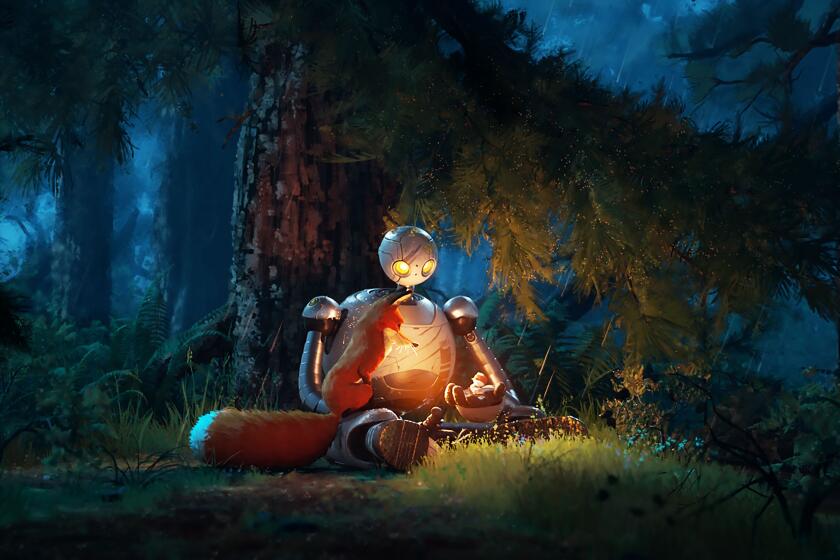Powell’s Dream Weavers
For director Michael Powell, the pursuit of love, art and truth transcended all known rules of time, space and reason. This is exquisitely reflected in the films he made with partner Emeric Pressburger--those mystical, dreamlike fables that LACMA celebrates in a four-week series beginning Saturday.
Fittingly, his own life was like a fable, culminating with the happiest of endings. The last 10 years, 1980 to 1990, were spent in romantic bliss with Thelma Schoonmaker, the Oscar-winning editor of “Raging Bull” he married in 1984 after a quiet courtship. It was Martin Scorsese who first introduced the 75-year-old Powell to the 45-year-old Schoonmaker in a bit of fortuitous matchmaking right out of “The Life and Death of Colonel Blimp.”
And why not? She was Scorsese’s protegee (they met as film students at NYU) and Powell had been a mentor for Scorsese, who resurrected his reputation in the mid-’70s by championing his forgotten films and then rescued him from obscurity by bringing him to New York.
As his widow, Schoonmaker-Powell continues the resurgence, attending retrospectives around the world. So she’ll be in town Saturday to introduce a rare Technicolor screening of “The Red Shoes.”
“I love going to retrospectives and seeing young people responding to them,” she says from New York during a break from editing “Kundun,” Scorsese’s December film about the young Dalai Lama. “Young men come up to me. Michael got to see some of it happening. It constantly renews your own pleasure. They’re like companions.”
Appropriately, the first time she met Powell was at Scorsese’s apartment while she was editing “Raging Bull” in 1979. “Marty finally located Michael in England and brought him back and we had a nice chat; then critic/novelist David Thomson got him his position at Dartmouth; and he later worked for Francis Coppola at Zoetrope [Studios] in L.A.”
“Marty began educating me about his films. While I was working, he rushed in one afternoon and insisted I look at a video of “I Know Where I’m Going,’ which he had just discovered. What a great job I had.”
She had a lot of catching up to do. Yet while falling under the spell of Powell and his films over the next few years, she remained under the influence of Scorsese--a talented editor in his own right and has collaborated on each of his films since “Raging Bull.”
“Marty was profoundly influenced by Michael’s films. He studied his camera work and his editing. They’re different--Marty uses improvisation and he’s gritty--but both are committed to a certain truth, even if it’s difficult to handle. They’re not made nervous because they know that’s how human beings are. They love eccentricities . . . an incredible use of camera, editing, music and acting. Fearlessness.
“When they were honoring Marty at the Toronto Film Festival, they showed a ‘Boxcar Bertha’ sequence, and Michael said, ‘I don’t understand why people object to Marty’s violence.’ He said it reminded him of Goya’s ‘The Disasters of War’ etchings. He adored ‘Mean Streets.’ He would stop on a street in New York and say, ‘Why isn’t “Mean Streets” playing every day?’ ”
Powell’s favorite among his own films was “A Matter of Life and Death,” which finally makes its home video debut (from Columbia/TriStar) on Oct. 14 under the more familiar title “Stairway to Heaven.” His preference for the celestial fantasy reveals a lot: a hopeful vision of eternal love surviving any obstacle in this world (depicted in glorious Technicolor) or the next (depicted in monochromatic black and white).
Quite a contrast with Pressburger’s favorite, the more structurally complex “Colonel Blimp”--no less spiritual or fantastic or colorful, but containing at its core a bittersweet vision of love unrequited.
“I’ve noticed with Michael’s films, I came to love and admire ‘A Matter of Life and Death.’ There would be a year when I’d see it four or five times. At first, mine and Marty’s favorites were ‘Blimp’ and ‘Red Shoes.’ That one has bravado, daring, freedom. ‘I’ll do whatever I want.’ ‘Blimp’ is really so dense. Every time you see it, you see three or four things you never see before.
“ ‘Never explain, never look down at your audience,’ Michael used to say. ‘They’re always 10 years ahead of you.’ He’d do one take often of Roger Livesey and Deborah Kerr in ‘Blimp.’ Not like today. Michael never did understand that’s how directors work today with 14 takes. Never be afraid of showing what’s on an actor’s face. And he knew how to use special effects so you couldn’t tell. He wasn’t afraid to use Livesey’s double right up close in ‘I Know Where I’m Going.’
Before falling in love with the director, Schoonmaker-Powell thought she knew where she was going, too, like the obstinate heroine played by Wendy Hiller. She was consumed by her film career and not interested in marriage, having witnessed how unhappy her parents were.
“He had an incredible ability to live life, unlike so many artists. He had an understanding about love and taught me about that. We were married in an English village with the butcher, the baker and the candlestick maker. We didn’t have to, but I wanted the ritual.
“He enriched every day. He would change the fruit in the bowl when I came home for lunch--it was like a still life. Then he would change it again when I came home for dinner. If I was tired, he would stand there waiting for me wearing something startling, colorful, arresting to pick up my spirits.”
Powell’s final triumph as a storyteller was his two-volume autobiography, masterfully revealing the almost surreal convergence of his life and films. With his health failing, however, his wife provided affectionate assistance.
“When we worked on the book, that was our highlight. His eyesight would go and I would read to him from his diary or a poem he liked. It was wonderful, his splashing forward and back, in the first volume. He had a cottage in England and we would sort through all the things he collected. He always had a sense of film as social history. I had to complete the second volume after he passed away.”
Right now, she immerses herself in the exotic “Kundun,” another departure for Scorsese, like “The Age of Innocence,” possessing its Powell influences.
“It’s a world that Marty plunges you into and has you believe and feel you’re there. None of the cast are actors. It’s their tragedy. The way they’re living is on their faces. It’s really a poem, this film. It doesn’t explain it, it evokes it . . . the culture, the tragedy, the man.”
More to Read
Only good movies
Get the Indie Focus newsletter, Mark Olsen's weekly guide to the world of cinema.
You may occasionally receive promotional content from the Los Angeles Times.










